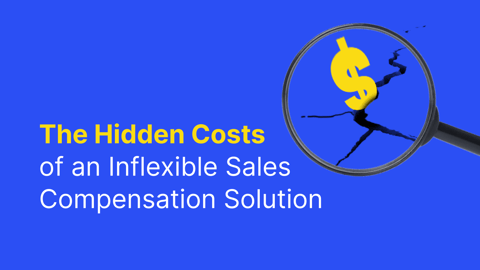Creating an SDR Compensation Plan for Your B2B Sales Team
By now we know that sales – more than most other professions – are motivated by money. You can’t find a successful B2B sales organization that doesn’t pay their sales reps some sort of commission.
It’s standard now, and there are data sets and real-world examples to back up the best ways to set up your compensation plans for maximum effectiveness.
In this blog, we’re going to break down SDR team metrics that we’ve seen successful sales organizations are using as targets in their compensation plans as well as some helpful tips to keep in mind when creating and implementing your SDR compensation plan.
To start out, we think a SDR compensation plan comes down to two separate but related questions:
-
What are you trying to incentivize your SDR team to deliver?
-
What’s in their control to achieve?
Those are the two main things you need to answer in order to create an SDR compensation plan that works for your business.
Creating an SDR compensation plan
From working with our customers, the main compensation targets we’ve seen are:
-
Meetings booked/completed
-
Pipeline generated
-
Conversion to closed-won
The volume for any of these targets should be based on your go-to-market approach. For example, a high-velocity sales team will generate substantially more meetings than an enterprise sales team, so you’ll need to evaluate your benchmarks accordingly.
Let’s take a look at each one of those targets individually and look at how they (1) incentivize your SDR team to deliver and (2) how much control they have over them.
Meetings booked/completed
Almost every SDR team measures the number of activity metrics – like phone calls, emails, social touches, etc. – to make sure the team is sending enough sales activity. But many teams have shifted from the number of sales activities as a target, to the number of meetings booked (from that sales activity.)
The reason is because SDRs are easily able to superficially reach a sales activity target by employing a spray-and-pray method of outreach. They’re able to play catch-up whenever they want by pumping out templated emails without spending time researching the prospect or personalizing the outreach in any sort of significant way.
By using meetings booked/completed instead of strictly sales activity as a target, you’re able to strike a better balance between the number of sales activities going out and the effort and personalization that goes behind them.
Pipeline generated
There’s an ongoing debate on including pipeline generated (or revenue generated) in an SDRs compensation plan.
On one side of the argument, you can say that SDRs don’t care about pipeline generated or closed-won business because they don’t have control over how the rest of the sales team works their opportunities down the funnel.
You can also say that they aren’t as motivated to hit that number because it’s too far away. If you have a 1-year sales cycle, and opportunities don’t typically hit a pipeline stage until 3-months in, you don’t end up getting compensated for the work you’re doing today for 3+ months.
On the other side of the argument, you say that the reason you have a sales team is to generate revenue for the business, and so the pipeline generated or revenue generated by an SDR is far more important than the number of activities they do each day, the number of meetings they book, or any other activity metric you can think of.
At the end of the day, would you rather have an SDR that books 20 meetings per week but only $10,000 in pipeline or an SDR that books 5 meetings per week that turn into $50,000 in pipeline?
Conversion to closed-won
Similar to the pipeline generated target, companies track conversion to closed-won in their SDR compensation plan to measure the quality of opportunities being passed onto the rest of the sales team.
Although the SDR team doesn’t have a direct impact on how their sourced opportunities flow through the sales pipeline and turn into revenue, they do control the quality of opportunities they pass along.
Similar example as above, would you rather an SDR that books 20 meetings per week but only generates $5,000 in revenue or an SDR that books 5 meetings per week that turn into $30,000 in revenue?
What do we do?
We believe an SDR compensation plan should be based off the number of meetings completed, and offering SPIFs (sales performance incentive funds) for specific metrics you want to push the organization forward on.
In our case, we measure the conversion rate from SDR sourced meetings to revenue. Conversion to won by created date is a great way to validate SDR performance over the long-term and prevent any unsavory behaviors that could game the compensation system.
More considerations when making an SDR compensation plan
Here are 4 things to keep in mind when creating your SDR compensation plan:
Make it simple
No more than 3 targets or goals that your SDRs are compensated on.
Make it understandable
There shouldn’t be any complicated formulas for SDRs to know what they are making each month/quarter – make it as straightforward as possible.
Make it impactful to business growth
The point of sales is to bring money into the business, so at least part of your SDR compensation plan should directly tied to pipeline or revenue generated.
Make it as immediate as possible
Motivation works best when the benefits are received in the near future – try to keep the time between activity and compensation within 90-days.
Make a plan that works for management, your SDR team, and the business
A win-win-win is what you’re aiming for.
A win for the sales team, because they have a clear compensation plan with targets that make sense.
A win for the business growth because sales reps are motivated to hit goals that drive growth.
And a win for whoever is managing this because it’ll be easy to manage and pay-out SDRs that hit their targets.
Getting to that win-win-win situation with your SDR compensation plan starts and ends with answering the question we posed at the start of this blog: what are you trying to incentivize your SDR team to deliver and what’s in their control to achieve?
Once you’ve answered that question – as a business – you’ll be in a great position to start your SDR compensation plan. Remember to keep it simple, understandable to everyone, impactful to the business, and as immediate as possible. With that in mind, you’re well on your way towards a win-win-win.



